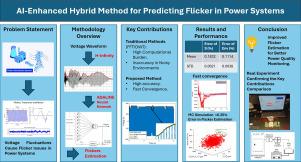电力系统闪变估计的混合人工智能方法
IF 9.6
Q1 COMPUTER SCIENCE, ARTIFICIAL INTELLIGENCE
引用次数: 0
摘要
介绍了一种结合H-∞滤波和自适应线性神经元(ADALINE)网络的配电系统闪变分量估计新方法。该方法利用H-∞滤波器的鲁棒性提取不确定和噪声条件下的电压包络,然后使用ADALINE准确识别嵌入在包络中的iec定义的标准频率下闪烁分量的相对幅度(ΔVi/Vt)。这种协同作用使有效的时域估计具有快速收敛和噪声弹性,解决了现有频域方法的主要局限性。与传统技术不同,这种混合模型处理复杂的功率干扰,而不需要事先了解噪声特性或广泛的训练。为了验证该方法的性能,我们基于IEC标准61000-4-15进行了仿真研究,并通过统计分析、蒙特卡罗模拟和实际数据进行了支持。结果表明,与基于快速傅立叶变换(FFT)和基于离散小波变换(DWT)的估计器相比,具有更高的精度、鲁棒性和更少的计算负荷。本文章由计算机程序翻译,如有差异,请以英文原文为准。

A hybrid Artificial Intelligence method for estimating flicker in power systems
This paper introduces a novel hybrid method combining H- filtering and an adaptive linear neuron (ADALINE) network for flicker component estimation in power distribution systems. The proposed method leverages the robustness of the H- filter to extract the voltage envelope under uncertain and noisy conditions, followed by the use of ADALINE to accurately identify the relative amplitudes of flicker components () at standard IEC-defined frequencies embedded in the envelope. This synergy enables efficient time-domain estimation with rapid convergence and noise resilience, addressing key limitations of existing frequency-domain approaches. Unlike conventional techniques, this hybrid model handles complex power disturbances without prior knowledge of noise characteristics or extensive training. To validate the method’s performance, we conduct simulation studies based on IEC Standard 61000-4-15, supported by statistical analysis, Monte Carlo simulations, and real-world data. Results demonstrate superior accuracy, robustness, and reduced computational load compared to Fast Fourier Transform (FFT) and Discrete Wavelet Transform (DWT)-based estimators.
求助全文
通过发布文献求助,成功后即可免费获取论文全文。
去求助
来源期刊

Energy and AI
Engineering-Engineering (miscellaneous)
CiteScore
16.50
自引率
0.00%
发文量
64
审稿时长
56 days
 求助内容:
求助内容: 应助结果提醒方式:
应助结果提醒方式:


